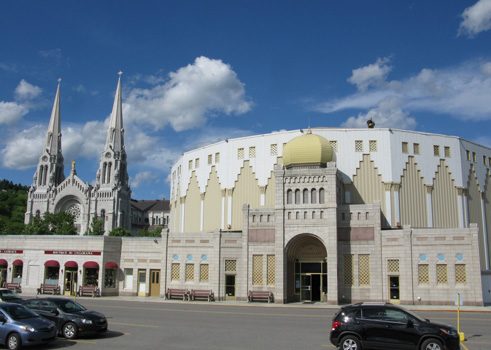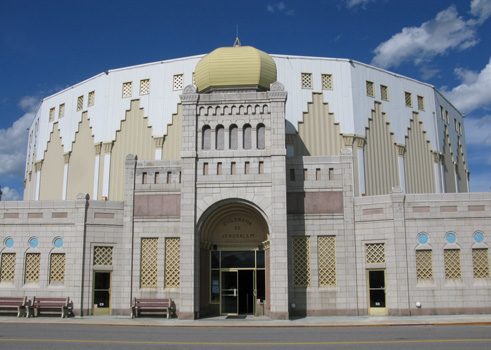Bruno Piglhein
German Traces in Quebec
Bruno Piglhein’s Panorama in Sainte-Anne-de-Beaupré
The enormous painting “Cyclorama de Jérusalem” in Sainte-Anne-de-Beaupré shows the crucifixion of Christ. The little town of Sainte-Anne is located around 30 km east of Quebec City on the north shore of the Saint Lawrence River, and is best known for its basilica, an impressive Catholic church and one of North America’s well-known places of pilgrimage.
How did this painting end up in the Canadian province of Quebec, when the artist came from Hamburg by birth and Munich by choice?
Bruno Piglhein was born in Hamburg in 1848. After finishing school, he trained as a sculptor and then later as a painter. He worked in several ateliers and studied at the Akademie für Bildende Künste in Dresden (Dresden Academy of Fine Arts) and at an art school in Weimar. When he was 22 years old, he moved to Munich. In 1885 and 1886, he travelled to Paris and Jerusalem for studies related to his later masterpiece “The Crucifixion of Christ” (“Die Kreuzigung Christi”). When he returned to Munich, Piglhein became a professor, and as such was part of the founding of the Munich Secession in 1892. He had particular success as a painter of religious and mythological subjects. The Munich businessman Joseph Halder commissioned Bruno Piglhein to paint a panorama depicting Jerusalem at the time of Christ’s crucifixion. Piglhein was responsible for the first sketches (hence his visits to Jerusalem), and he completed the painting together with the landscape artists Josef Block, Johann Adalbert Heine, and Joseph Krieger. The Piglhein panorama “The Crucifixion of Christ” (which was 14 metres tall and 100 metres wide) was exhibited in Munich on June 1st, 1886. These kinds of panoramas were very popular in the 19th century, and they became a form of mass media. The enormous paintings were displayed in purpose-built circular buildings, and they would travel from city to city to reach a wider audience. This was also the case with the Bruno Piglhein panorama, which was exhibited in Berlin and Vienna after its time in Munich. Unfortunately, the painting was burned in a fire in Vienna in 1892, much to Piglhein’s dismay. There aren’t any exact details of how the fire came about.
But how did a copy of the Piglhein panorama, made to the same dimensions, arrive in Sainte-Anne-de-Beaupré?
Since panoramas were so popular in the 19th century, there were specialized companies in Paris, Brussels, Munich, Milwaukee, and Chicago where panoramas were produced. Paul Philippoteaux, the son of the famous French landscape artist Félix-Antoine Philippoteaux, opened the atelier Chicago Panorama Inc. in the USA. It’s here that the term ‘Cyclorama’ was first used. The panorama of the crucifixion of Christ that is displayed in Sainte-Anne-de-Beaupré was created in this atelier. From this point, the stories differ. Some say that this copy (as well as another copy in Switzerland) were made without the knowledge or agreement of Piglhein and his Munich colleagues. Other sources report that the American businessman Ernest Pierpont, who worked in the panorama business, had met Piglhein personally. According to this version of events, Piglhein sent Pierpont the studies from his visit to Jerusalem in 1855, along with other documents, in order to make a reproduction of the crucifixion scene possible.
In any event, Pierpont commissioned a group of reputable painters led by Paul Philippoteaux to create the panorama Cyclorama de Jérusalem displayed today in Sainte-Anne. It was brought from Chicago to Montreal in either 1888 or 1889, and it was exhibited there in a specially designed building on the corner of Rue Sainte-Catherine and Rue Saint-Urbain. The panorama and its building changed owners several times until it became the property of the Blouin family in Sainte-Anne. They have been managing it under the name ‘Cyclorama de Jérusalem’ to this day. On the company’s homepage, Piglhein is expressly credited as the initiator of the piece. It remains unknown whether or not he provided the American Pierpont with his sketches, plans, and other information. The imposing painting, the special lighting, and the trompe l’œil technique all convey the sense that the viewer is standing in the middle of the events of Jesus’ crucifixion in Jerusalem.
Cyclorama de Jérusalem
8 Rue du Sanctuaire
Sainte-Anne-de-Beaupré
Québec, G0A 3C0

